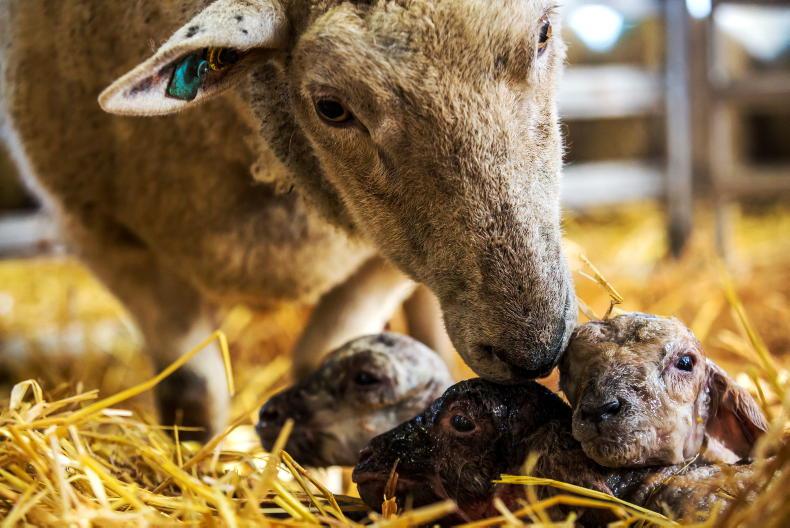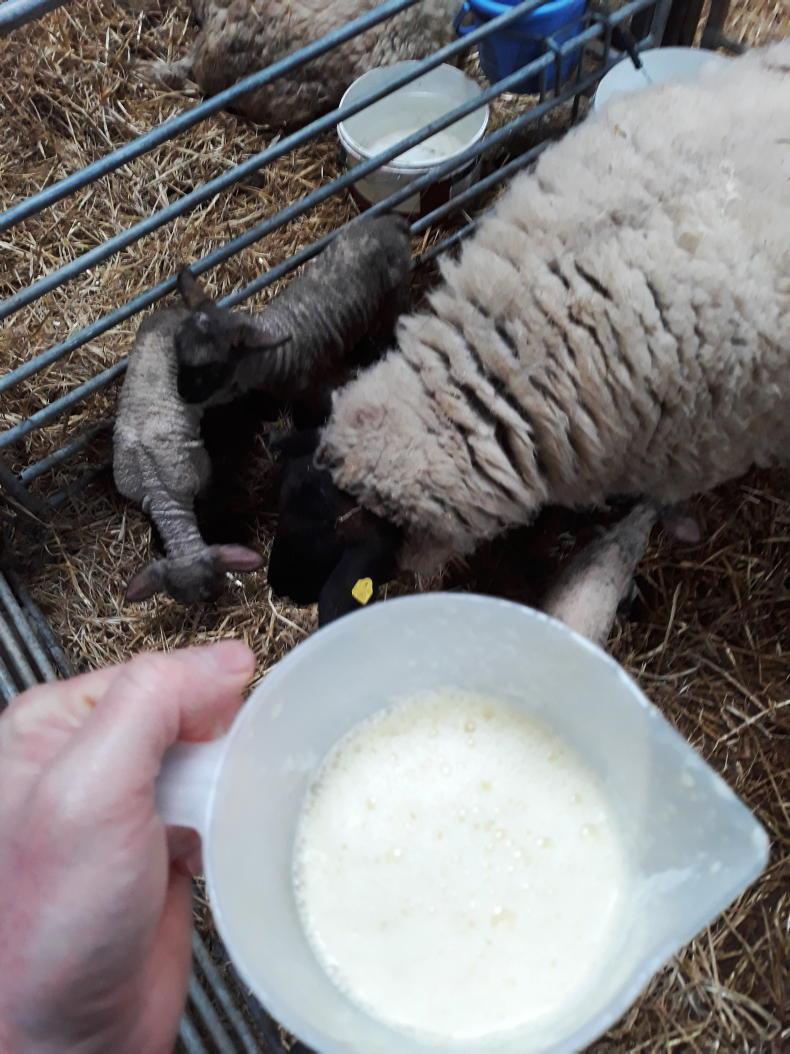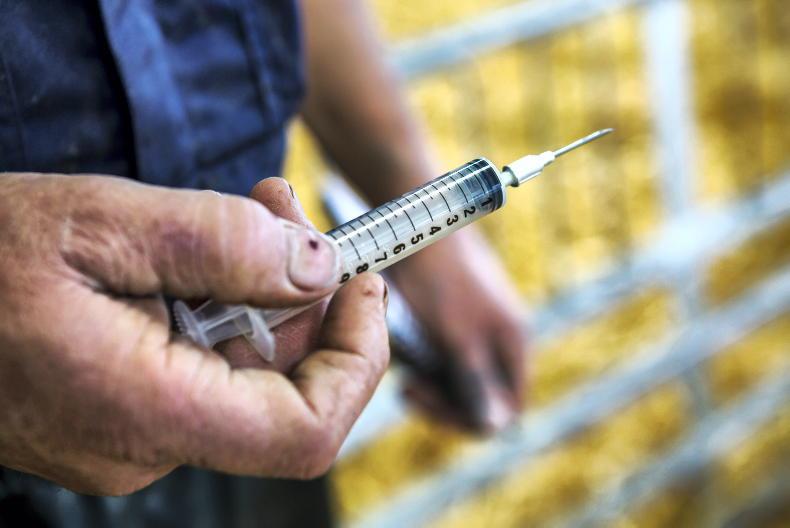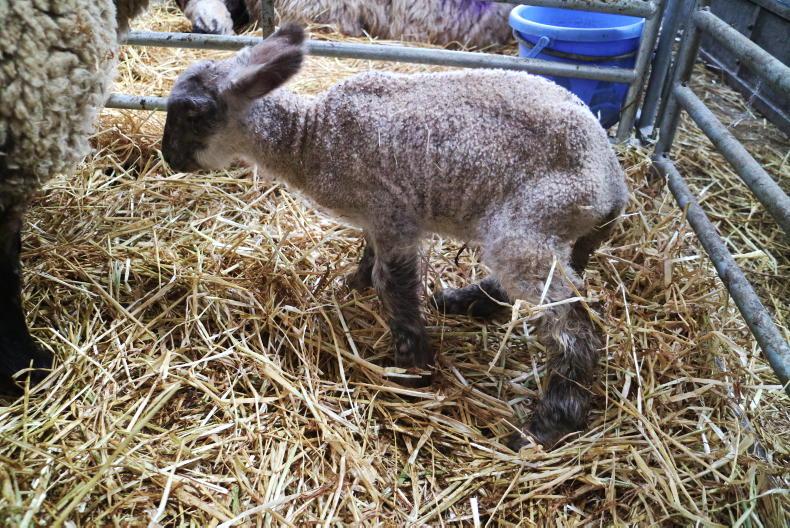There is a growing spotlight across human and animal health on antibiotic usage.
This stems from the fact that an increasing number of antibiotics are succumbing to drug-resistant bacteria while there is also a significant death toll related to this issue.
A global strategy termed the One Health concept aims to tackle the growing problem of antimicrobial resistance (AMR). Achieving this goal requires co-operation and collaboration across species and all relevant stakeholders involved in the respective industries.
Ireland is committed to the initiative, with the Department of Agriculture having a major role in the One Health National Action Plan (iNAP), which it launched in conjunction with the Department of Health in 2017. A second plan is currently being worked upon and is planned to be released in 2021.
The code of good practice for the sheep sector was launched in September 2020
As part of Ireland’s goal to limit antibiotic usage, a code of good practice has been developed for each enterprise. This highlights the main areas where antibiotics are used and details advice to limit usage levels.
The code of good practice for the sheep sector was launched in September 2020 and is described as being a useful tool for sheep farmers in working to address the challenge of antimicrobial resistance.
Practical advice
The guidelines contained in the code of practice were developed by Veterinary Ireland, Irish Farmers Association and Teagasc and focus on the responsible prescription and use of antibiotics in farm animals. As such, a number of diseases which are linked to antibiotic usage in sheep systems are addressed.
Some farmers whose flocks have suffered from the disease have progressed down an avenue of administering antibiotics to lambs at birth
The primary section discusses health management of newborn lambs and pays particular attention to watery mouth disease. The condition is caused by colonisation of the small intestine by E coli, with rapid multiplication and the release of harmful toxins.
Some farmers whose flocks have suffered from the disease have progressed down an avenue of administering antibiotics to lambs at birth, typically in the form of spectinomycin. However, this option is not a realistic solution to the problem, with an increasing number of farms reporting resistance and finding themselves in a very tricky position.

The cleanliness of the environment in to which lambs are born will have a major influence on disease risk. \ Philip Doyle
The optimum manner of controlling watery mouth disease must therefore be to put a solid preventative programme in place and safeguard antibiotic usage for when an outbreak occurs or in exceptional circumstances.
Disease establishment
The code of practice outlines that newborn lambs are probably the most immunologically naïve animals on the farm. Their immune system has not developed to a stage where they can recognise common bacteria and viruses in the environment and be in a position to fight them off.
Stress or exposure to high levels of pathogens in the environment will allow disease to quickly establish, with diarrhoea (scour) and watery mouth disease the most prevalent in newborn lambs. The document states the term watery mouth is a description which encompasses a collection of clinical signs in newborn lambs including lethargy, failure to suck, profuse salivation, bloating and retained meconium.
To manage the disease successfully, all of these risks must be addressed
The document goes on to say that these ailments all have something in common – they are caused by a combination of trademark factors such as a naïve immune system, insufficient or no passive transfer of antibodies from colostrum, a buildup of infectious agents in the environment (such as dirty bedding/equipment, poor operator hygiene when intervening at lambing or handling newborn lambs and any other stressors such as the movement of mixing of lambs between groups.
To manage the disease successfully, all of these risks must be addressed. The following are essential points aimed at preventing the disease having an opportunity to become established:
Supply and timing: ensuring lambs get a sufficient and prompt supply of colostrum which contains antibodies against diseases present in the environment is the most valuable preventative practice available. The recommendation is to supply lambs with a minimum of 50ml of colostrum per kilo of liveweight within the first six hours of life and at least 200ml/kg liveweight within the first 24 hours. Colostrum will provide a protective covering to the gut lining, which will help bacteria and viruses from establishing. If a lamb is unable to suckle then it should be stomach-tubed. Lamb birthweight and colostrum quality: correct nutrition is important to ensure correct lamb birth weights and good-quality colostrum. Birthweight has a big bearing on lamb viability and their ability to get up and suckle quickly. There is a happy medium as the further lambs are born below the optimum weight or above the optimum weight the higher mortality will be. Teagasc research states the optimum birth weight, based on lamb mortality, for lambs born as singles, twins and triplets is 6.0kg, 5.6kg and 4.7 kg, respectively. Both colostrum quantity and quality is very dependent on feeding adequate-quality protein to pregnant ewes in late gestation. UCD research shows that where energy intake in the last four weeks of pregnancy is 20% deficient then it will reduce the volume of colostrum produced in the first hour of lactation and thereafter during early lactation. Twin-bearing ewes in late pregnancy require in the region of 200g of protein daily, with soya bean meal the preferred choice. Colostrum substitutes: the ideal scenario is to try to get at least some colostrum into each lamb from a ewe on the farm. This will at least ensure there is an opportunity for the lamb to receive some antibodies that have been produced to guard against diseases in the environment. For example, in the case of multiple births where a ewe has insufficient milk to feed all of her lambs, then each lamb could receive a quantity of colostrum with all three receiving a top-up from another ewe or a ewe colostrum substitute. Cow colostrum, which again has ideally been produced by a cow on the farm, is highlighted as a reasonable substitute for ewe colostrum. The code of practice recommends the cow from which the colostrum is being obtained should preferably be vaccinated with a clostridial and pasteurella vaccine pre-calving. If progressing down this route, then the advice is to increase the volume of cow colostrum fed to the newborn lamb by 30% to account for a lower concentration. Take care also that there is a risk of introducing disease, with Johne’s disease the highest-profile culprit. Colostrum substitutes are viewed as a poor replacement for ewe or cow colostrum and, as such, every effort should be made to ensure each lamb receives some ewe colostrum. Research carried out in UCD shows the lifetime performance of lambs who received only a colostrum substitute at birth was 17% lower than lambs which received ewe colostrum. Colostrum preparation: overheating colostrum should be avoided as it will denature the protein structures of the antibodies and render them useless from an immunological point of view. Teagasc advises a maximum water temperature of 40oC. A tip to defrost colostrum quicker is to store it in smaller containers or sealable freezer bags as this will increase the surface contact with the water and reduce the time it takes to defrost. Care should also be taken when preparing colostrum substitutes and refrain from using boiling water. Water which has been boiled and allowed to cool is ideal for this purpose. 
Milking the ewe and ensuring each lamb gets a volume of colostrum will greatly aid in helping to build natural immunity and prevent disease establishing.
Reducing environment risk exposure: the main source for the lamb to pick up bacteria is from the environment in which it is born into. There is a risk of lambs ingesting bacteria from dirty straw bedding, a dirty fleece or udder in ewes or dirty feeding equipment for example. The code of practice sets out a routine for practising good hygiene that includes power hosing, disinfecting and liming of lambing pens combined with plentiful use of straw. Hygiene is not just important during the lambing period. Ewes should also be managed in late gestation in a manner that reduces the risk of fleece and udder contamination with faeces, clay, etc. Where ewes are particularly dirty, then they will benefit from crutching. Longer-term winter shearing or belly crutching of housed ewes can be considered as a management tool to help keep ewes cleaner. In terms of feeding equipment, syringes, stomach tubes, etc, should be washed in warm soapy water and sterilised between each use. Also, the navels of lambs should be disinfected as soon as possible after birth to reduce the risk of disease entering via this avenue.
Weaning your flock away
out of oral antibiotics
Going “cold turkey” in using oral antibiotics is a difficult prospect for flocks that have built up a mindset of having to use them annually.
Stepping away from routine use and only treating high-risk lambs is one way to gradually break the link.

Where an outbreak occurs then samples should be sent for analysis to establish the optimum choice of treatment. \ Philip Doyle.
For example, some farmers have successfully stepped away by opting in year one to treat high-risk lambs such as those born in a triplet or higher litter size, lambs born to ewes with milk yield problem or yearling hoggets with insufficient milk or born late in the season followed by a further step back in year two.
The consequences of failing to do so are too great to comprehend, with reports in recent years of flocks suffering high mortality rates due to drug-resistant bacteria developing.
Vaccination can also play a role but, again, the basic principles of ensuring lambs receive sufficient colostrum are paramount. Where there are significant issues in a flock, then it is important to consult your vet so that samples or dead lambs can be submitted to identify what strain of E coli is responsible and identify the most suitable treatment approach.
There is a growing spotlight across human and animal health on antibiotic usage.
This stems from the fact that an increasing number of antibiotics are succumbing to drug-resistant bacteria while there is also a significant death toll related to this issue.
A global strategy termed the One Health concept aims to tackle the growing problem of antimicrobial resistance (AMR). Achieving this goal requires co-operation and collaboration across species and all relevant stakeholders involved in the respective industries.
Ireland is committed to the initiative, with the Department of Agriculture having a major role in the One Health National Action Plan (iNAP), which it launched in conjunction with the Department of Health in 2017. A second plan is currently being worked upon and is planned to be released in 2021.
The code of good practice for the sheep sector was launched in September 2020
As part of Ireland’s goal to limit antibiotic usage, a code of good practice has been developed for each enterprise. This highlights the main areas where antibiotics are used and details advice to limit usage levels.
The code of good practice for the sheep sector was launched in September 2020 and is described as being a useful tool for sheep farmers in working to address the challenge of antimicrobial resistance.
Practical advice
The guidelines contained in the code of practice were developed by Veterinary Ireland, Irish Farmers Association and Teagasc and focus on the responsible prescription and use of antibiotics in farm animals. As such, a number of diseases which are linked to antibiotic usage in sheep systems are addressed.
Some farmers whose flocks have suffered from the disease have progressed down an avenue of administering antibiotics to lambs at birth
The primary section discusses health management of newborn lambs and pays particular attention to watery mouth disease. The condition is caused by colonisation of the small intestine by E coli, with rapid multiplication and the release of harmful toxins.
Some farmers whose flocks have suffered from the disease have progressed down an avenue of administering antibiotics to lambs at birth, typically in the form of spectinomycin. However, this option is not a realistic solution to the problem, with an increasing number of farms reporting resistance and finding themselves in a very tricky position.

The cleanliness of the environment in to which lambs are born will have a major influence on disease risk. \ Philip Doyle
The optimum manner of controlling watery mouth disease must therefore be to put a solid preventative programme in place and safeguard antibiotic usage for when an outbreak occurs or in exceptional circumstances.
Disease establishment
The code of practice outlines that newborn lambs are probably the most immunologically naïve animals on the farm. Their immune system has not developed to a stage where they can recognise common bacteria and viruses in the environment and be in a position to fight them off.
Stress or exposure to high levels of pathogens in the environment will allow disease to quickly establish, with diarrhoea (scour) and watery mouth disease the most prevalent in newborn lambs. The document states the term watery mouth is a description which encompasses a collection of clinical signs in newborn lambs including lethargy, failure to suck, profuse salivation, bloating and retained meconium.
To manage the disease successfully, all of these risks must be addressed
The document goes on to say that these ailments all have something in common – they are caused by a combination of trademark factors such as a naïve immune system, insufficient or no passive transfer of antibodies from colostrum, a buildup of infectious agents in the environment (such as dirty bedding/equipment, poor operator hygiene when intervening at lambing or handling newborn lambs and any other stressors such as the movement of mixing of lambs between groups.
To manage the disease successfully, all of these risks must be addressed. The following are essential points aimed at preventing the disease having an opportunity to become established:
Supply and timing: ensuring lambs get a sufficient and prompt supply of colostrum which contains antibodies against diseases present in the environment is the most valuable preventative practice available. The recommendation is to supply lambs with a minimum of 50ml of colostrum per kilo of liveweight within the first six hours of life and at least 200ml/kg liveweight within the first 24 hours. Colostrum will provide a protective covering to the gut lining, which will help bacteria and viruses from establishing. If a lamb is unable to suckle then it should be stomach-tubed. Lamb birthweight and colostrum quality: correct nutrition is important to ensure correct lamb birth weights and good-quality colostrum. Birthweight has a big bearing on lamb viability and their ability to get up and suckle quickly. There is a happy medium as the further lambs are born below the optimum weight or above the optimum weight the higher mortality will be. Teagasc research states the optimum birth weight, based on lamb mortality, for lambs born as singles, twins and triplets is 6.0kg, 5.6kg and 4.7 kg, respectively. Both colostrum quantity and quality is very dependent on feeding adequate-quality protein to pregnant ewes in late gestation. UCD research shows that where energy intake in the last four weeks of pregnancy is 20% deficient then it will reduce the volume of colostrum produced in the first hour of lactation and thereafter during early lactation. Twin-bearing ewes in late pregnancy require in the region of 200g of protein daily, with soya bean meal the preferred choice. Colostrum substitutes: the ideal scenario is to try to get at least some colostrum into each lamb from a ewe on the farm. This will at least ensure there is an opportunity for the lamb to receive some antibodies that have been produced to guard against diseases in the environment. For example, in the case of multiple births where a ewe has insufficient milk to feed all of her lambs, then each lamb could receive a quantity of colostrum with all three receiving a top-up from another ewe or a ewe colostrum substitute. Cow colostrum, which again has ideally been produced by a cow on the farm, is highlighted as a reasonable substitute for ewe colostrum. The code of practice recommends the cow from which the colostrum is being obtained should preferably be vaccinated with a clostridial and pasteurella vaccine pre-calving. If progressing down this route, then the advice is to increase the volume of cow colostrum fed to the newborn lamb by 30% to account for a lower concentration. Take care also that there is a risk of introducing disease, with Johne’s disease the highest-profile culprit. Colostrum substitutes are viewed as a poor replacement for ewe or cow colostrum and, as such, every effort should be made to ensure each lamb receives some ewe colostrum. Research carried out in UCD shows the lifetime performance of lambs who received only a colostrum substitute at birth was 17% lower than lambs which received ewe colostrum. Colostrum preparation: overheating colostrum should be avoided as it will denature the protein structures of the antibodies and render them useless from an immunological point of view. Teagasc advises a maximum water temperature of 40oC. A tip to defrost colostrum quicker is to store it in smaller containers or sealable freezer bags as this will increase the surface contact with the water and reduce the time it takes to defrost. Care should also be taken when preparing colostrum substitutes and refrain from using boiling water. Water which has been boiled and allowed to cool is ideal for this purpose. 
Milking the ewe and ensuring each lamb gets a volume of colostrum will greatly aid in helping to build natural immunity and prevent disease establishing.
Reducing environment risk exposure: the main source for the lamb to pick up bacteria is from the environment in which it is born into. There is a risk of lambs ingesting bacteria from dirty straw bedding, a dirty fleece or udder in ewes or dirty feeding equipment for example. The code of practice sets out a routine for practising good hygiene that includes power hosing, disinfecting and liming of lambing pens combined with plentiful use of straw. Hygiene is not just important during the lambing period. Ewes should also be managed in late gestation in a manner that reduces the risk of fleece and udder contamination with faeces, clay, etc. Where ewes are particularly dirty, then they will benefit from crutching. Longer-term winter shearing or belly crutching of housed ewes can be considered as a management tool to help keep ewes cleaner. In terms of feeding equipment, syringes, stomach tubes, etc, should be washed in warm soapy water and sterilised between each use. Also, the navels of lambs should be disinfected as soon as possible after birth to reduce the risk of disease entering via this avenue.
Weaning your flock away
out of oral antibiotics
Going “cold turkey” in using oral antibiotics is a difficult prospect for flocks that have built up a mindset of having to use them annually.
Stepping away from routine use and only treating high-risk lambs is one way to gradually break the link.

Where an outbreak occurs then samples should be sent for analysis to establish the optimum choice of treatment. \ Philip Doyle.
For example, some farmers have successfully stepped away by opting in year one to treat high-risk lambs such as those born in a triplet or higher litter size, lambs born to ewes with milk yield problem or yearling hoggets with insufficient milk or born late in the season followed by a further step back in year two.
The consequences of failing to do so are too great to comprehend, with reports in recent years of flocks suffering high mortality rates due to drug-resistant bacteria developing.
Vaccination can also play a role but, again, the basic principles of ensuring lambs receive sufficient colostrum are paramount. Where there are significant issues in a flock, then it is important to consult your vet so that samples or dead lambs can be submitted to identify what strain of E coli is responsible and identify the most suitable treatment approach.









 This is a subscriber-only article
This is a subscriber-only article











SHARING OPTIONS: